
The kwacha is the currency of Malawi as of 1971, replacing the Malawian pound. It is divided into 100 tambala. The kwacha replaced other types of currency, namely the British pound sterling, the South African rand, and the Rhodesian dollar, that had previously circulated through the Malawian economy. The exchange rate of the kwacha undergoes fixed periodical adjustments, but since 1994 the exchange rate has floated. In 2005, administrative measures were put in place by Bingu wa Mutharika to peg the exchange rate with other currencies. Banknotes are issued by the Reserve Bank of Malawi. In May 2012, the Reserve Bank of Malawi devalued the kwacha by 34% and unpegged it from the United States dollar. The currency was further devalued by 25% by the central bank in May 2022 followed by another 44% devaluation in November 2023 raising inflation rate in Malawi.

The Australian dollar is the official currency and legal tender of Australia, including all of its external territories, and three independent sovereign Pacific Island states: Kiribati, Nauru, and Tuvalu. As of 2022, it is the sixth most-traded currency in the foreign exchange market and also the seventh most-held reserve currency in global reserves.

The paʻanga is the currency of Tonga. It is controlled by the National Reserve Bank of Tonga in Nukuʻalofa. The paʻanga is not convertible and is pegged to a basket of currencies comprising the Australian, New Zealand, and United States dollars and the Japanese yen.
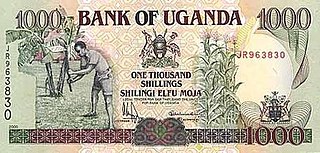
The shilling is the currency of Uganda. Officially divided into cents until 2013, due to substantial inflation the shilling now has no subdivision.
The Bermudian dollar is the official currency of the British Overseas Territory of Bermuda. It is subdivided into 100 cents. The Bermudian dollar is not normally traded outside Bermuda, and is pegged to the United States dollar at a one-to-one ratio. Both currencies circulate in Bermuda on an equal basis.

The Fijian dollar has been the currency of Fiji since 1969 and was also the currency between 1867 and 1873. It is normally abbreviated with the dollar sign $, or alternatively FJ$ to distinguish it from other dollar-denominated currencies. It is divided into 100 cents.

The Jamaican dollar has been the currency of Jamaica since 1969. It is often abbreviated to J$, the J serving to distinguish it from other dollar-denominated currencies. It is divided into 100 cents, although cent denominations are no longer in use as of 2018. Goods and services may still be priced in cents, but cash transactions are now rounded to the nearest dollar.
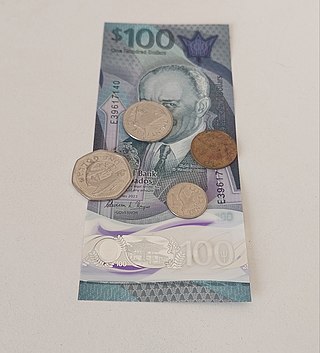
The dollar has been the currency of Barbados since 1935. Globally its currency has the ISO 4217 code BBD, however, unofficially in Barbados the International vehicle registration code BDS is also commonly used, a currency code that is otherwise reserved for Bangladesh outside Barbados. As such the present Barbados dollar has the official ISO 4217 code of BB which matches the [dot] .bb Cc-TLD domain names classification for Barbados under ISO 3166, plus D for dollar in the foreign exchange market. The Barbadian dollar is considered as a currency which can be divided into 100 cents, though the 1 cent coin is in the process of being phased out.
The Solomon Islands dollar is the currency of Solomon Islands since 1977. Its symbol is $, with SI$ used to differentiate it from other currencies also using the dollar sign. It is subdivided into 100 cents.
The tālā is the currency of Samoa. It is divided into 100 sene. The terms tālā and sene are the equivalents of the English words dollar and cent in the Samoan language. Its symbol is $, or WS$ to distinguish it from other currencies named dollar.
The Tuvaluan dollar is one of the currencies of Tuvalu, whose unofficial international currency code is TVD. Tuvalu has never had banknotes of its own, and has been issuing coins since 1976. However, the Tuvaluan dollar is used as a unit of account, and is pegged to the Australian dollar at parity. From 1966 to 1976, Tuvalu officially used the Australian dollar. In 1976, Tuvalu began issuing its own coins, which continue to circulate alongside Australian coins. Tuvalu continues to use Australian banknotes. Tuvaluan coins are not legal tender in Australia. Similar to the Faroese króna's relationship to the Danish krone and the Panamanian balboa's relationship to the United States dollar, the Tuvaluan dollar is not an independent currency, but a variation of the Australian dollar.
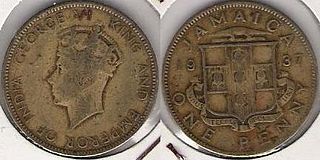
The pound was the official currency of Jamaica between 1840 and 1969. It circulated as a mixture of sterling coinage and locally issued coins and banknotes and was always equal to the pound sterling. The Jamaican pound was also used in the Cayman and Turks and Caicos Islands.

The Cook Islands dollar was the former currency of the Cook Islands, which now uses the New Zealand dollar, although some physical cash issued for the Cook Islands dollar remains in use. The dollar was subdivided into 100 cents, with some older 50-cent coins carrying the denomination as "50 tene".

The Kiribati dollar is one of the two official currencies of Kiribati. The Kiribati coins are pegged at 1:1 ratio to the Australian dollar, the other official currency of Kiribati. Kiribati coins were issued in 1979 and circulate alongside banknotes and coins of the Australian dollar. Kiribati coins are nowadays very few in comparison to Australian coins, the last minor emission has been made in 1992, and these old coins are generally collected. The complete emissions of coins were made in 1979 and in 1989 for the tenth anniversary of independence.
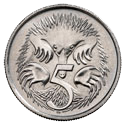
The Australian five-cent coin is the lowest-denomination circulating coin of the decimal Australian dollar introduced in 14 February 1966, replacing the pre-decimal sixpence. It has been the lowest-denomination coin in general circulation since the withdrawal of the one-cent and two-cent coins in 1992.
The coins of Canada are produced by the Royal Canadian Mint and denominated in Canadian dollars ($) and the subunit of dollars, cents (¢). An effigy of the reigning monarch always appears on the obverse of all coins. There are standard images which appear on the reverse, but there are also commemorative and numismatic issues with different images on the reverse.
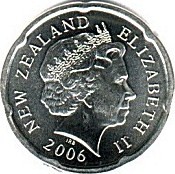
The New Zealand twenty-cent coin is the second-lowest-denomination coin of the New Zealand dollar. The 20-cent coin was introduced when the New Zealand dollar was introduced on 10 July 1967, replacing the New Zealand florin coin. Its original reverse of a kiwi was changed in 1990 when the image was moved onto the one-dollar coin. In 2006 its size was reduced and its edge altered to a Spanish flower as part of a revision of New Zealand's coins, which also saw its alloy become nickel-plated steel instead of cupro-nickel.
The coins of the Australian dollar were introduced on 14 February 1966, although they did not at that time include the one-dollar or two-dollar coins. The dollar was equivalent in value to 10 shillings in the former currency.
The coins of the New Zealand dollar are used for the smallest physical currency available in New Zealand. The current denominations are ten cents, twenty cents, fifty cents, one dollar and two dollars. The $1 and $2 coins are minted in a gold colour, the 20c and 50c coins are silver colour and the 10c coin is plated in copper.
The New Zealand fifty-cent coin is a coin of the New Zealand dollar. It was the largest by denomination, diameter and mass to have been introduced on the decimalisation of the currency on 10 July 1967, replacing the pre-decimal crown coin. A total of 81,585,200 pre-2006 50 cent coins were issued, with a total value of $40,792,600.00











